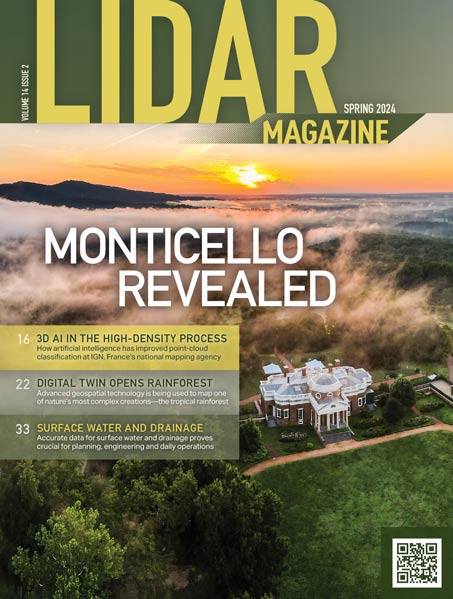Nottingham, UK, 02 January 2014 – ZEB1 the worlds first truly mobile, hand held, rapid laser mapping system has been put through a rigorous testing process at the worlds deepest and most substantial gold mine. Owned and operated by Anglogold Ashanti the Mponeng Mine in South Africa is over 2 kilometres below sea level. The ZEB1 was demonstrated in an up dip stope panel and the resulting 3D model was proven to conform to existing plans of the mine workings.
Before commissioning any new equipment we always undertake rigorous testing as the environment in which we operate is so extreme; with virgin rock temperatures around 60 degrees Centigrade and working temperatures between 30 and 35 degrees. commented Michael Harcombe, Senior Mine Surveyor at Anglogold Ashantis Mponeng Mine. At these ambient levels, sensitive equipment, such as laser scanners, often just do not work!
The results of the ZEB1 test were much better than we could possibly have expected, he continued. The model generated from the ZEB1 scanning was placed in the mines plans for a comparison with the current excavation and found to conform to the outline of the workings. We were hoping to compare the results with our existing laser scanning set up however the test area was simply too small for traditional laser scanners another significant advantage for the ZEB1.
The Mponeng Mine is located between the towns of Carletonville and Fochville on the border between Gauteng and the North West Province, southwest of Johannesburg. The operation, the worlds deepest mine, extracts the Ventersdorp Contact Reef (VCR) at depths between 2,400 metres and 3,900 metres through sequential-grid mining producing more than 500,000 ounces of gold a year.
Developed by CSIRO and commercialised by UK based 3D Laser Mapping, ZEB1 uses robotic technology called Simultaneous Localisation and Mapping (SLAM). The ZEB1 system includes a lightweight laser scanner mounted on a simple spring mechanism, which continuously scans as the operator walks through the environment. As the scanner loosely oscillates about a spring it produces a rotation that converts 2D laser measurements into 3D fields of view. Its ability to self-localise makes ZEB1 ideally suited for use indoors, underground and in other covered environments where traditional solutions that utilise GPS dont function well.
Anglogold Ashanti already operate a traditional terrestrial laser scanner at the Mponeng Mine. The RIEGL VZ-400, purchased from 3D Laser Mapping, is used to monitor workings for signs of deformation; a common phenomenon as rocks at such depths can be under enormous pressure. Anglogold Ashanti also use the VZ-400 to determine off-line and grade mining, eradicating the need for later redevelopment and therefore reworking of areas already mined.
CONTACTS:
Editorial enquiries to Robert Peel, robert@market-it.co.uk, +44 (0)1666 823306
Reader and advertising enquiries to charlie.whyman@3dlasermapping. com, +44 (0)1949 838 004
Colour separation requests to robert@market-it.co.uk
www.3dlasermapping.com
Notes to Editors:
ZEB1 was developed by CSIRO, Australias national science agency, and is licenced to GeoSLAM (a UK based start-up company). The competitively priced ZEB1, now exclusively available from 3D Laser Mapping, allows for fast data capture without any complex set up. ZEB1 is easy to use, truly portable and does not require expensive software or high end computers to process the captured data.
3D Laser Mapping is a global developer of laser scanning solutions for sectors such as mapping, mining and manufacturing. 3D Laser Mapping specialises in integrating laser scanning hardware with their own software and peripherals to create solutions at the cutting edge of technology. Through a worldwide network of distributors 3D Laser Mapping is able to provide frontline support and service for a growing international client base. For further information see www.3dlasermapping.com
CSIRO, the Commonwealth Scientific and Industrial Research Organisation, is Australia’s national science agency and one of the largest and most diverse research agencies in the world. CSIRO works with leading scientific organisations around the world, and is recognised internationally for the quality of its research. CSIRO’s research is performed by the 11 Divisions, which are the business units of CSIRO. CSIRO is one of the largest and most diverse scientific institutions in the world with more than 6500 staff located across 56 sites throughout Australia and overseas. For further information see www.csiro.au
CSIROs Digital Productivity and Services Flagship is a $48 million research initiative targeting productivity growth in Australia through frontier services innovation and by unlocking the value of a national broadband infrastructure. Through its research the flagship will help add value to the Australian economy by developing and delivering more efficient and innovative services that improve peoples wellbeing and prosperity. For further information see www.csiro.au/dpas
